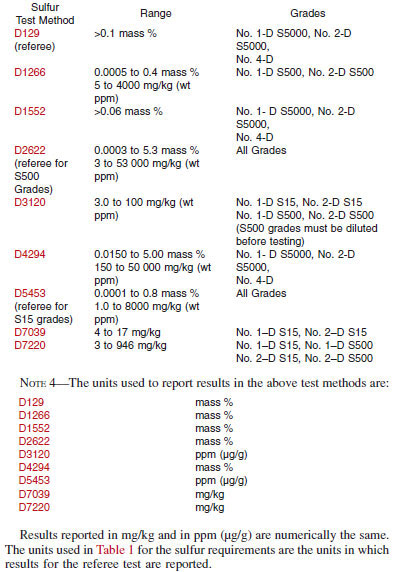4. Sampling, Containers, and Sample Handling
4.1 It is strongly advised to review all test methods prior to sampling to understand the importance and effects of sampling technique, proper containers, and special handling required for each test method.
4.2 Correct sampling procedures are critical to obtaining a representative sample of the diesel fuel oil to be tested. Refer to Appendix X2 for recommendations. The recommended procedures or practices provide techniques useful in the proper sampling or handling of diesel fuels.
5. Test Methods
5.1 The requirements enumerated in this specification shall be determined in accordance with the following methods:
5.1.1 Flash Point - Test Methods D93, except where other methods are prescribed by law. For all grades, Test Method D3828 may be used as an alternate with the same limits. For Grades No. 1-D S15, No. 1-D S500 , No. 1-D S5000, No. 2-D S15, No. 2-D S500, and No. 2-D S5000, Test Method D56 may be used as an alternate with the same limits, provided the flash point is below 93°C and the viscosity is below 5.5 mm2 /s at 40°C. This test method will give slightly lower values. In cases of dispute, Test Methods D93 shall be used as the referee method. Test Method D56 may not be used as the alternate method for Grade No. 4-D because its minimum viscosity limit is 5.5 mm2/s at 40°C.
5.1.2 Cloud Point - Test Method D2500. For all fuel grades in Table 1, the automatic Test Methods D5771, D5772, or D5773 can be used as alternates with the same limits. Test Method D3117 can also be used since it is closely related to Test Method D2500. In case of dispute, Test Method D2500 shall be the referee method.
5.1.3 Water and Sediment - Test Method D2709 is used for fuel Grades No. 1-D S15, No. 1-D S500, No. 1-D S5000, No. 2-D S15, No. 2-D S500, and No. 2-D S5000. Test Method D1796 is used for Grade No. 4-D.
5.1.4 Carbon Residue - Test Method D524 is used for fuel Grades No. 1-D S15, No. 1-D S500, No. 1-D S5000, No. 2-D S15, No. 2-D S500 and No. 2-D S5000. Grade No. 4-D does not have a limit for carbon residue.
5.1.5 Ash - Test Method D482 is used for all grades in Table 1.
5.1.6 Distillation - Test Method D86 is used for Grades No. 1-D S15, No. 1-D S500, No. 1-D S5000, No. 2-D S15, No. 2-D S500, and No. 2-D S5000. For all grades, Test Method D2887 or Test Method D7345 can be used as an alternate. Results from Test Method D2887 shall be reported as "Predicted D86" results by application of the correlation in Appendix X5 of Test Method D2887 to convert the values. Results from Test Method D7345 shall be reported as "Predicted D86" results by application of the corrections described in Test Method D7345 to convert to D86 equivalent values. In case of dispute, Test Method D86 shall be the referee method. Grade No. 4-D does not have distillation requirements.
5.1.7 Viscosity - Test Method D445 is used for all fuel grades in Table 1.
5.1.8 Sulfur - The following list shows the referee test methods and alternate test methods for sulfur, the range over which each test method applies and the corresponding fuel grades.

5.1.9 Copper Corrosion - Test Method D130, 3-h test at a minimum control temperature of 50°C. This test method is used for fuel Grades No. 1-D S15, No. 1-D S500, No. 1-D S5000, No. 2-D S15, No. 2-D S500 and No. 2-D S5000. Grade No. 4-D does not have a copper corrosion requirement.
5.1.10 Cetane Number - Test Method D613 is used for all fuel grades in Table 1. Test Method D6890 or Test Method D7170 may be used for all No. 1-D and No. 2-D grades with the DCN result being compared to the cetane number specification requirement of 40. Test Method D613 shall be the referee method.
5.1.11 Cetane Index - Test Methods D976–80 is used for fuel Grades No. 1-D S15, No. 1-D S500, No. 2-D S15 and No. 2-D S500. Grades No. 1-D S5000, No. 2-D S5000 and No. 4-D do not have an aromatics content requirement, so do not use this test method as a surrogate for aromatics content.
5.1.12 Aromaticity - Test Method D1319. This test method provides an indication of the aromatics content of fuels. For fuels with a maximum final boiling point of 315°C, this method is a measurement of the aromatic content of the fuel. This test method is used for fuel Grades No. 1-D S15, No. 1-D S500, No. 2-D S15 and No. 2-D S500. Grades No. 1-D S5000, No. 2-D S5000 and No. 4-D do not have an aromatics content requirement.
5.1.13 Lubricity - Test Method D6079 or D7688. Test Method D6079 shall be the referee method.
5.1.14 Conductivity - Both conductivity test methods, Test Methods D2624 and D4308 are allowed for all grades of No. 1 and No. 2 diesel fuels. There is no conductivity requirement for No. 4 diesel fuel. For conductivities below 1 pS/m, Test Method D4308 is preferred.



